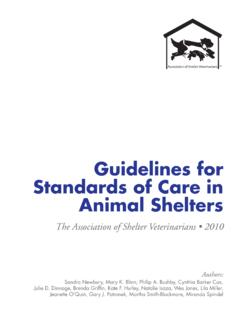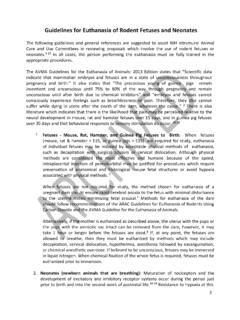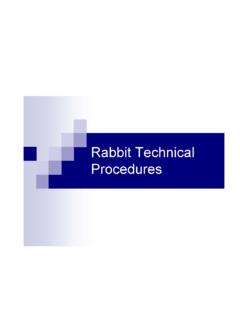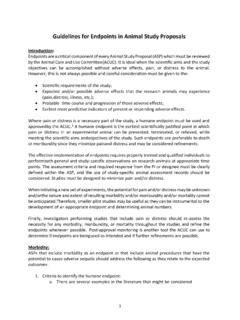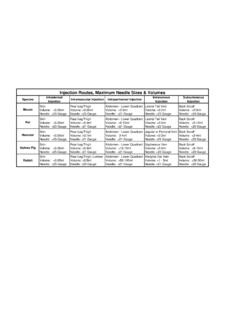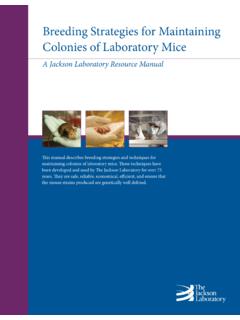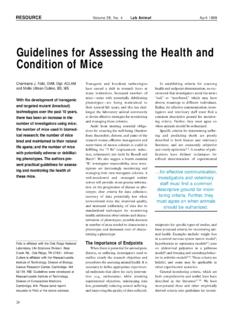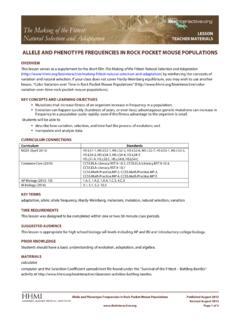Transcription of Guidelines for Blood Collection in Mice and Rats
1 Guidelines for Blood Collection in Mice and RatsOverview: These Guidelines have been developed to assist investigators and National Institutes of Health (NIH) Institute/Center (IC) Animal Care and Use Committees (ACUC) in their choice and application of survival rodent bleeding techniques. The Guidelines are based on peer-reviewed publications1-9 and data and experience accumulated at NIH. The researcher and the veterinary staff should decide which survival bleeding technique is appropriate. All Blood sampling (including technique, frequency and volume) must be in an approved Animal Study Proposal (ASP) or referred to in an ACUC reviewed Standard Operating Procedure.
2 It is the responsibility of both the researcher and the IC ACUC to select/approve the procedures that result in the least pain and distress to the animal, while adequately addressing the needs of the experimental design. Any exceptions to these Guidelines , increase in Blood volume or frequency to be collected, retro-orbital bleeding without use of topical anesthesia, or surgical cannulation must be scientifically justified in the ASP. General: As with any procedure, training is critically important. Training and experience of the phlebotomist in the chosen procedure are of paramount importance.
3 Training opportunities and resources, including access to experienced investigators and veterinarians, must be made available to new personnel. Each Principal Investigator must ensure sufficient training for individuals performing these technical procedures. In addition, individual IC ACUCs should establish lines of accountability to oversee the training of their personnel. The procedures utilized must be reviewed and approved by the IC ACUC prior to implementation. The Office of Animal Care and Use (OACU) has additional training resources on its website to include survival rodent Blood Collection : Factors to consider when selecting the appropriate Blood Collection technique for research purposes include, but are not limited to: The species to be bled The size and age of the animal to be bled and the estimated total Blood volume The type of the sample required ( serum, whole Blood cells, etc.)
4 The quality of the sample required (sterility, tissue fluid contamination, etc.) The quantity of Blood required (taking into account extraneous Blood loss due to a selected method) The frequency of sampling The health status of the animal being bled The training and experience of the phlebotomist The size and type of capillary tube is appropriate The effect of the site, restraint or anesthesia on the Blood parameter measured10-15 The acceptable quantity and frequency of Blood sampling is dependent on the circulating Blood volume of the animal and the red Blood cell (RBC) turnover rate. The approximate circulating Blood volume of adult rodents varies with species and body weight (mouse 63 to 80 ml/kg (mean 72 ml/kg) and rat 58-70 ml/kg (mean 64 ml/kg)).
5 3 Of the circulating Blood volume, approximately 10% of the total volume can be safely removed every 2 to 4 weeks, every 7 days, and 1% every 24 ,18 Based on animal welfare indices the NIH veterinary recommended Blood volume to use is 55 to 70 ml/kg when calculating quantity. Volumes greater than recommended should be justified in the ASP and appropriate fluid and/or cellular replacement provided. Calculated Blood sample ranges, based on recommended body weight are provided in Table 1. RBC life span of the mouse: 38-47 days. RBC life span of the rat: 42-65 Table 1: Calculated Blood Sample Volumes for Species and Range of Body Weights Species Body weight (g) *CBV(ml)
6 ~1% CBV every 24 hrs ~ CBV every 7 days ~10% CBV every 2 - 4wks Mouse 20 - 11 - 14 l 90 - 105 l 110 - 140 l 25 - 14 - 18 l 102 - 131 l 140 - 180 l 30 - 17 - 21 l 124 - 158 l 170 - 210 l 35 - 19 - 25 l 145 - 184 l 190 - 250 l 40 - 22 - 28 l 165 - 210 l 220 - 280 l Rat 125 - 69 - 88 l 516 - 656 l 690 - 880 l 150 - 82 - 105 l 619 - 788 l 820 - 1000 l 200 - 110 - 140 l 825 1050 l - ml 250 - 138 - 175 l ml - ml 300 - 165 - 210 l ml - ml 350 - 193 - 245 l ml - ml *Circulating Blood volume (1ml = 1000 l) Maximum sample volume for that sampling frequency The following Guidelines refer to the most frequently used survival sampling sites: a) submandibular plexus; b) saphenous vein); c) tail vein; d) retro-orbital; e) jugular vein; f) submental.
7 Blood withdrawal by cardiac puncture is considered an euthanasia procedure and should be performed only after ensuring that the animal is under deep anesthesia, as evidenced by lack of response to a painful stimulus ( , toe or tail pinch). Procedures: Basic recommendations for each survival bleeding technique are provided below. Submandibular Blood Sampling (limited to adult mice):8,10-12,22-24 Obtainable Blood volumes: medium to large. Repeated sampling is possible by alternating sides of the face. General anesthesia not required Sample may be a mixture of venous and arterial Blood . Can be performed rapidly and with a minimal amount of equipment, allowing for rapid completion.
8 Sample volume can be partially controlled with the size of needle (20 gauge or smaller) or lancet (4 mm) used to puncture the site. Proper manual restraint of awake animals results in proper site alignment and venous compression for good Blood flow Blood is drawn from a small vascular bundle at the back of the jaw. The puncture site is caudal to the small cowlick Not recommended for serial draws (> than 2 draws per side)25 Clinical chemistry values may be higher with this method than with the retro-orbital plexus Saphenous Sampling (medial or lateral approach):26-28 Obtainable Blood volumes: small to medium.
9 Can be used in both rats and mice by piercing the saphenous vein with a needle. Variable sample quality General anesthesia is not required, although effective restraint is required 17 Requires more hands-on training than tail or retro-orbital sampling to reliably withdraw more than a minimal amount of Blood . Although more esthetically acceptable than retro-orbital sampling, prolonged restraint and site preparation time can result in increased animal distress when handling an awake animal. Temporary favoring of limb may be noted following the procedure. Application of sterile petroleum jelly to the site may assist the Blood to bead and in turn enhance total Blood volumes captured.
10 The clot/scab can be gently removed for repeated small samples if serial Collection is required. Lateral Tail Vein or Ventral/Dorsal Artery Sampling:29-31 Obtainable volumes for cannulation or nicking: artery medium to large. Vein small In general, arterial sampling produces larger volumes and is faster, but special care must be taken to ensure adequate hemostasis. For this reason, the artery should only be used if large volumes are needed. Can be used in both rats and mice by cannulating the Blood vessel or by superficially nicking the vessel perpendicular to the tail. General anesthesia not required, although effective restraint is required.

